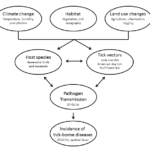Dr. Collins’ research focuses on the increased appearance of tick-borne illnesses in the Southeast. The outcomes of this research are being used to develop new ecological impact models to reduce these diseases and improve human health outcomes in the region.
Some contagious diseases are transmissible between animals and humans; well-known examples of these “zoonotic” diseases include Ebola, SARS, and West Nile. For some diseases, detailed studies have determined the important ecological determinants that influence transmission to humans. But for others, such as emerging tick-borne diseases in the Southeast, the causes and ecological drivers remain elusive.
Three species of tick commonly occur in the Southeast: lone star tick, American dog tick, and Gulf Coast tick. The lone star tick is the most abundant and is a vector of dangerous human pathogens, including Rocky Mountain Spotted Fever, which has an epicenter in west Tennessee (Adjemian et al. 2009). Bites from lone star ticks can also cause a well-documented disease of unknown cause that mimics the symptoms of Lyme disease (Masters et al. 2008).
Tick distributions are dynamic, and recent changes are hypothesized to reflect changing land use patterns, increasing populations of deer and other wildlife hosts, globalization, and climate change (Léger et al. 2013). Range expansions by the lone star and American dog ticks have resulted in overlapping populations in southwest Tennessee. Both ticks are competent vectors of Ehrlichia, which causes vomiting, high fevers, and muscle and joint aches and is the most common zoonotic pathogen in Tennessee ticks (Moncayo et al. 2010). Risk of Ehrlichia infection varies widely across the Southeast, and it is hypothesized that spatial variation in risk is due to regional differences in the abundance of tick species. We have incomplete data on the current distribution of ticks and their associated pathogens and only a fragmentary understanding of the ecological factors that limit their distribution and abundance in the Southeast.
Tick distributions depend strongly on the distribution and abundance of host species such as birds and mammals (Paddock and Yabsley 2007). Vegetation and climate affect tick distributions indirectly through their influence on host populations and directly because ticks are prone to desiccation (Gray 1991). During the course of the project, Professor Collins collaborated with two professors at the University of Memphis, one at Christian Brothers University, two at the University of Tennessee, and Dr. Allan Houston at Ames Plantation in Fayette County to examine how bird, mammal, and vegetative communities and landscape features influence tick densities across habitats at Ames Plantation. Professor Collins focused on the bird community. Because ticks have limited dispersal abilities, colonization depends on host movement. Transport of ticks by birds is common (Hasle 2013), and he concluded that birds are important contributors to the spread of tick-borne diseases.
Professor Collins developed models to identify the ecological variables that are associated with tick population densities and with the prevalence of Ehrlichia to construct an ecological framework to understand the factors that have caused an increase in the number and prevalence of tick-borne diseases in the Southeast (Figure 1). A major impact of this project was the development of effective strategies to control ticks and their associated pathogens to improve human health outcomes in the Southeast. A second community impact was the development of models that can predict the influence of climate change and changes in land use patterns to enhance our ability to respond to the probable emergence of other tick-borne diseases.
This project also impacted students. Students did not merely learn about science – project fellows did science. Other than experimental design, student fellows were involved in all aspects of this research. Fellows collected field data (conduct surveys and obtain blood samples from birds), they conducted lab work (DNA extraction and molecular assays to detect infections), they analyzed data, they coauthored papers, and they presented at national conferences. Students disseminated our findings through novel digital resources such as the Tick Encounter Resource Center established by the University of Rhode Island (tickencounter.org/tick_identification) and through an open-access database of blood proteomics at the University of Pennsylvania. This interdisciplinary research experience built on the student’s’ academic learning in ecology, parasitology, and microbiology and help them to develop skills in data collection, statistical analysis, and presentation of results.
Professor Collins anticipates that this research will result in multiple publications in prestigious, peer-reviewed ecological and epidemiological journals. These publications will make him competitive for external funding, and he and his collaborators submitted an NSF EEID (Ecology and Evolution of Infectious Diseases) proposal for the next funding cycle. This project is a natural extension of Professor Collins’ research in avian disease ecology and it promises to impact the students and the community by building a collaboration of local scientists and developing an ecological framework to understand risks and to develop strategies to combat current and emerging tick-borne diseases.

Michael Collins
Associate Professor of Biology
Dr. Collins’ research interests are broad but center on examining the determinants and consequences of species diversity at local, regional, and global scales.



